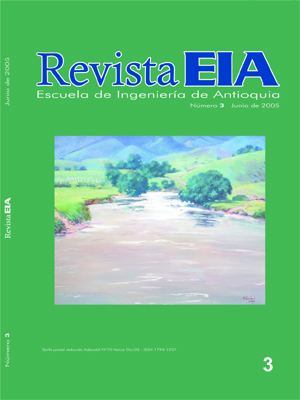APLICACIÓN DE LOS SIG PARA LA EVALUACIÓN DEL ESTADO DE CONSERVACIÓN DEL HÁBITAT DEL PAUJIL DE PICO AZUL CRAX ALBERTI (AVES: CRACIDAE) EN EL NORORIENTE DE ANTIOQUIA, COLOMBIA
APLICACIÓN DE LOS SIG PARA LA EVALUACIÓN DEL ESTADO DE CONSERVACIÓN DEL HÁBITAT DEL PAUJIL DE PICO AZUL CRAX ALBERTI (AVES: CRACIDAE) EN EL NORORIENTE DE ANTIOQUIA, COLOMBIA


This work is licensed under a Creative Commons Attribution-NonCommercial-NoDerivatives 4.0 International License.
Copyright statement
The authors exclusively assign to the Universidad EIA, with the power to assign to third parties, all the exploitation rights that derive from the works that are accepted for publication in the Revista EIA, as well as in any product derived from it and, in in particular, those of reproduction, distribution, public communication (including interactive making available) and transformation (including adaptation, modification and, where appropriate, translation), for all types of exploitation (by way of example and not limitation : in paper, electronic, online, computer or audiovisual format, as well as in any other format, even for promotional or advertising purposes and / or for the production of derivative products), for a worldwide territorial scope and for the entire duration of the rights provided for in the current published text of the Intellectual Property Law. This assignment will be made by the authors without the right to any type of remuneration or compensation.
Consequently, the author may not publish or disseminate the works that are selected for publication in the Revista EIA, neither totally nor partially, nor authorize their publication to third parties, without the prior express authorization, requested and granted in writing, from the Univeridad EIA.
Show authors biography
El paujil de pico azul, Crax alberti, es un ave endémica del norte de Colombia en peligro crítico de extinción, sometida a la pérdida del hábitat y a la cacería de subsistencia como principales amenazas. Se desarrolló una aplicación de Sistemas de Información Geográfica (SIG) para comparar el estado de conservación de las áreas de bosque, hábitat del paujil de pico azul, en 15 municipios de la región del nororiente de Antioquia en dos períodos de tiempo diferentes (1986 y 2002). La aplicación desarrollada que incorpora información cartográfica digital permitió clasificar ocho zonas definidas en el área de estudio para realizar un análisis de las prioridades de conservación. Se formularon, además, algunas recomendaciones para futuras aplicaciones de SIG como herramienta para la gestión de la conservación de especies amenazadas en Colombia.
Abstract: The blue-billed curassow, Crax alberti, is a critically endangered endemic bird from the northern part of Colombia, mainly subjected to habitat loss and subsistence hunting. Geographic Information Systems (GIS) were used to compare the conservation status of forested areas, habitat of the blue-billed curassow, in 15municipalities of the northeastern region of Antioquia for two different time periods (1986 and 2002). The developed application using digital cartography, allowed the classification of eight zones defined for the study area in order to analyze conservation priorities. Recommendations are made as well for future applications of GIS as a management tool for threatened species in Colombia.
Article visits 229 | PDF visits 194
